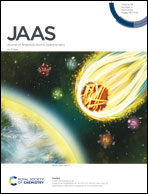Barite oxygen isotope reference materials for highly precise and accurate SIMS microanalysis†
Abstract
Barite is an important record of marine sulfate evolution throughout geologic history. Variations in oxygen isotope compositions (δ18O) at the microscale are highly important for studying the evolution of marine sulfate. However, the application of this proxy has been hindered due to the lack of reference materials for secondary ion mass spectrometry (SIMS) microanalysis. This study introduces two new potential reference materials, NJU-Ba-1 and FJ barite for microbeam oxygen isotope measurements. Detailed examinations of the texture and major elements revealed no internal zoning of ground fragments from the two barite reference materials. The recommended δ18OVSMOW values of NJU-Ba-1 and FJ were determined by gas-source isotope ratio mass spectrometry (GS-IRMS), with results of 7.94 ± 0.30‰ (2SD, N = 11) and 7.52 ± 0.34‰ (2SD, N = 8), respectively. SIMS instrumental stability was monitored by analyses of well characterized zircon references (Penglai and Qinghu), and the robustness of the SIMS barite δ18O measurements was further assessed by comparison with the values recommended by GS-IRMS. The effects of the crystallographic orientation, topography, and X–Y position on SIMS barite δ18O measurement were also examined. Multiple SIMS analyses suggest that both NJU-Ba-1 and FJ barite are homogeneous in oxygen isotope composition at the ∼20 μm level, with two standard deviations (2SD) of 0.36‰ (N = 383) and 0.58‰ (N = 325), respectively.



 Please wait while we load your content...
Please wait while we load your content...